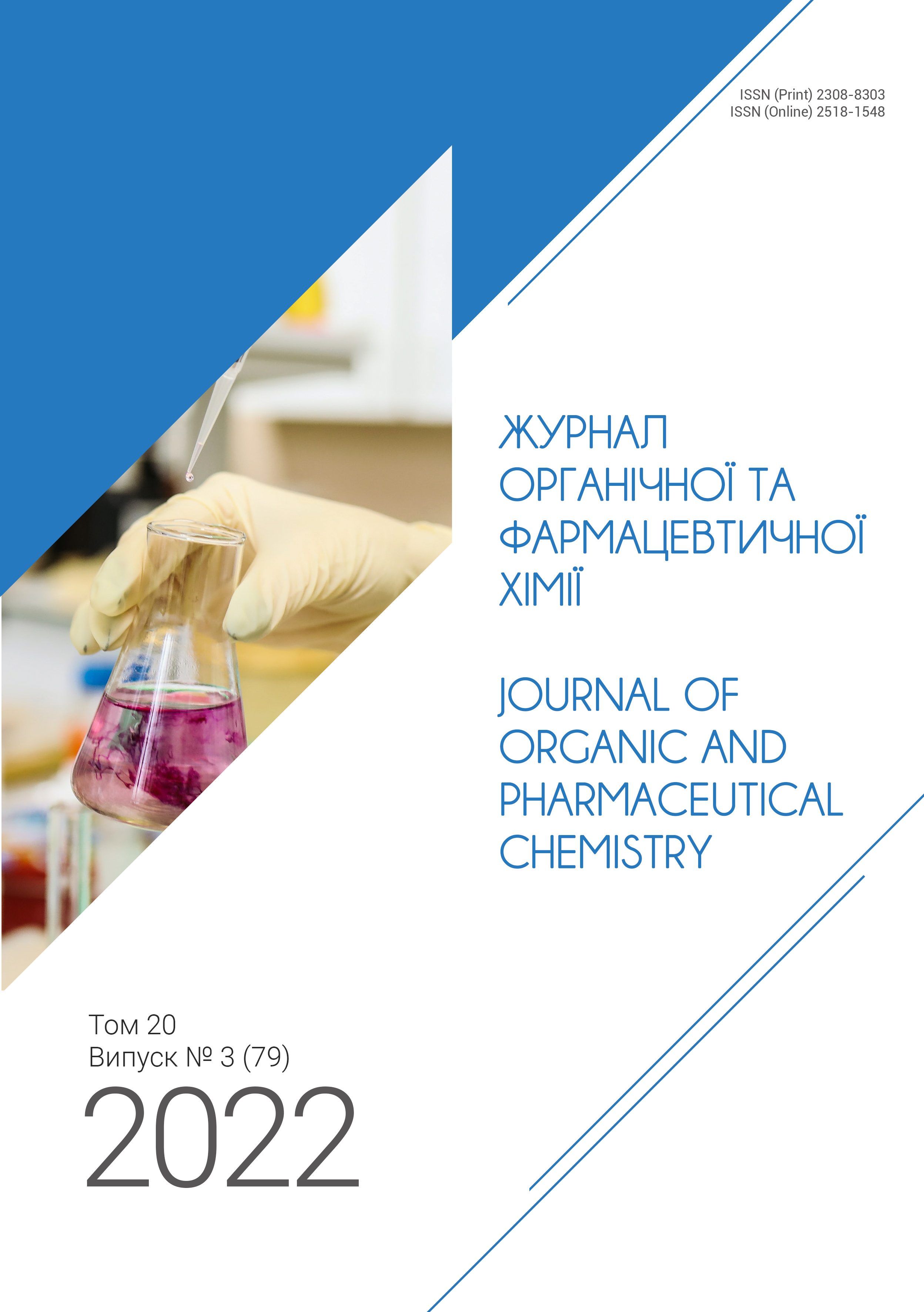The synthesis of N-substituted 4-fluoro-1,8-naphthalimides
DOI:
https://doi.org/10.24959/ophcj.22.263203Keywords:
acenaphthene, 1,8-naphthalimide, 1,8-naphthalic anhydride, alkylation, imidationAbstract
Aim. To synthesize 4-fluoro-1,8-naphthalic acid imide and its derivatives substituted in the imide ring.
Results and discussion. 4-Fluoro-1,8-naphthalimide was obtained using acenaphthene as the starting material. N-alkyl-4-fluoro-1,8-naphthalimides were synthesized via the phase transfer catalytic alkylation of 4-fluoro-1,8-naphthalimide with haloalkanes. Imidation of 4-fluoro-1,8-naphthalic anhydride with aminoacids resulted in the formation of N-carboxyalkyl-1,8-naphthalimides. These substances can be considered as potential fluorescent labels capable of binding to amino groups of various biological molecules as they contain carboxylic functionality in their structure.
Experimental part. The structure of the compounds synthesized was confirmed by FT-IR, 1H NMR and 13C NMR spectroscopy, and mass-spectrometry.
Conclusions. It has been shown that 4-fluoro-1,8-naphthalinedicarboxylic acid imide can be obtained following the synthetic route “acenaphthene – 5-fluoroacenaphthene – 4-fluoro-1,8-naphthalic anhydride – 4-fluoro-1,8-naphthalimide”. 4-Fluoro-1,8-naphthalimide can be alkylated by butyl iodide and octyl bromide using tetraalkylammonium salts as a phase transfer catalyst resulted in N-butyl-4-fluoro-1,8-naphthalimide and N-octyl-4-fluoro-1,8-naphthalimide. As a result, N-carboxyalkyl-4-fluoro-1,8-naphthalimides have been obtained for the first time by aminolysis of 4-fluoro-1,8-naphthalic anhydride with glycine, β-alanine and 6-aminocaproic acid.
Supporting Agency
- the work is a part of the departmental research at the Odesa I. I. Mechnikov National University on the topic “Synthesis and properties of condensation products of substituted naphthalic anhydrides with aromatic and aliphatic amines” (the State Registration No 0120U102722; the research period: 2020 – 2024).
Downloads
References
Ameuru, U. S.; Yakubu, M. K.; Bello, K. A.; Nkeonye, P. O.; Halimehjani, A. Z. Synthesis of disperse dyes derived from 4-amino-N-decyl-1,8-naphthalimide and their dyeing properties on polyester fabrics. Dyes Pigm. 2018, 157, 190-197. https://doi.org/10.1016/j.dyepig.2018.04.050.
- Kim, K.-W.; Kim, G.-H.; Kwon, S.-H.; Yoon, H.-I.; Son, J.-E.; Choi, J.-H. Synthesis and photophysical properties of blue-emitting fluorescence dyes derived from naphthalimide derivatives containing a diacetylene linkage group. Dyes Pigm. 2018, 158, 353-361. https://doi.org/10.1016/j.dyepig.2018.05.065.
- Fedko, N. F.; Anikin, V. F. A Convenient Way of 3-Fluoro-1,8-Naphthalimide Synthesis. J. Org. Pharm. Chem. 2015, 13 (4), 12-15. https://doi.org/10.24959/ophcj.15.857.
- Grabchev I., Konstantinova T. Synthesis of some polymerisable 1,8-naphthalimide derivatives for use as fluorescent brighteners. Dyes Pigm. 1997, 33, 197-203. https://doi.org/10.1016/S0143-7208(96)00053-8.
- Bezuglyi, M.; Ivaniuk, K.; Volyniuk, D.; Gražulevičius, J. V.; Bagdžiūnas, G. An approach to discovering novel exciplex supramolecular complex based on carbazole-containing 1,8-naphthalimide. Dyes Pigm. 2018, 149, 298-305. https://doi.org/10.1016/j.dyepig.2017.10.013.
- Liu, Q.; Fang, Y.; Yi, X.; Chen, R.; Zhang, Y. Synthesis and Metal Ion Probe Properties of Four 1,8-Naphthalimides. Asian J. Chem. 2013, 25 (6), 3325-3327. https://doi.org/10.14233/ajchem.2013.13649.
- Qiao, Q.; Liu, W.; Chen, J.; Zhou, W.; Yin, W.; Miao, L.; Cui, J.; Xu, Z. A naphthalimide-derived fluorogenic probe for SNAP-tag with a fast record labeling rate. Dyes Pigm. 2017, 147, 327-333. https://doi.org/10.1016/j.dyepig.2017.08.032.
- Sk, U. H.; Prakasha Gowda, A. S.; Crampsie, M. A.; Yun, J. K.; Spratt, T. E.; Amin, S.; Sharma, A. K. Development of novel naphthalimide derivatives and their evaluation as potential melanoma therapeutics. Eur. J. Med. Chem. 2011, 46 (8), 3331-3338. https://doi.org/10.1016/j.ejmech.2011.04.058.
- Tan, S.; Yin, H.; Chen, Z.; Qian, X.; Xu, Y. Oxo-heterocyclic fused naphthalimides as antitumor agents: Synthesis and biological evaluation. Eur. J. Med. Chem. 2013, 62, 130-138. https://doi.org/10.1016/j.ejmech.2012.12.039.
- Negwer, M.; Scharnow, H.-G. Organic-chemical drugs and their synonyms, 8th Ed.; Wiley-VCH; Weinheim, 2001; Vol. 2, P. 1250.
- Yagupol'skij, L. M.; Ivanova, Zh. М. Ftorproizvodnye acenaftena [Fluorine derivatives of acenaphthene, in Russian]. Zh. Obshch. Khim. 1957, 27 (8), 2273-2276.
Fischer, A.; Sutherland, G. J.; Topsom, R. D.; Vaughan, J. 1114. Dissociation constants of some naphthylamines and acenaphthenamines and their dimethyl derivatives. Journal of the Chemical Society (Resumed) 1965, (0), 5948-5953. https://doi.org/10.1039/JR9650005948.
Downloads
Published
How to Cite
Issue
Section
License
Copyright (c) 2022 National University of Pharmacy

This work is licensed under a Creative Commons Attribution 4.0 International License.
Authors publishing their works in the Journal of Organic and Pharmaceutical Chemistry agree with the following terms:
1. Authors retain copyright and grant the journal the right of the first publication of the work under Creative Commons Attribution License allowing everyone to distribute and re-use the published material if proper citation of the original publication is given.
2. Authors are able to enter into separate, additional contractual arrangements for the non-exclusive distribution of the journal’s published version of the work (e.g., post it to an institutional repository or publish it in a book) providing proper citation of the original publication.
3. Authors are permitted and encouraged to post their work online (e.g. in institutional repositories or on authors’ personal websites) prior to and during the submission process, as it can lead to productive exchanges, as well as earlier and greater citation of published work (see The Effect of Open Access).















